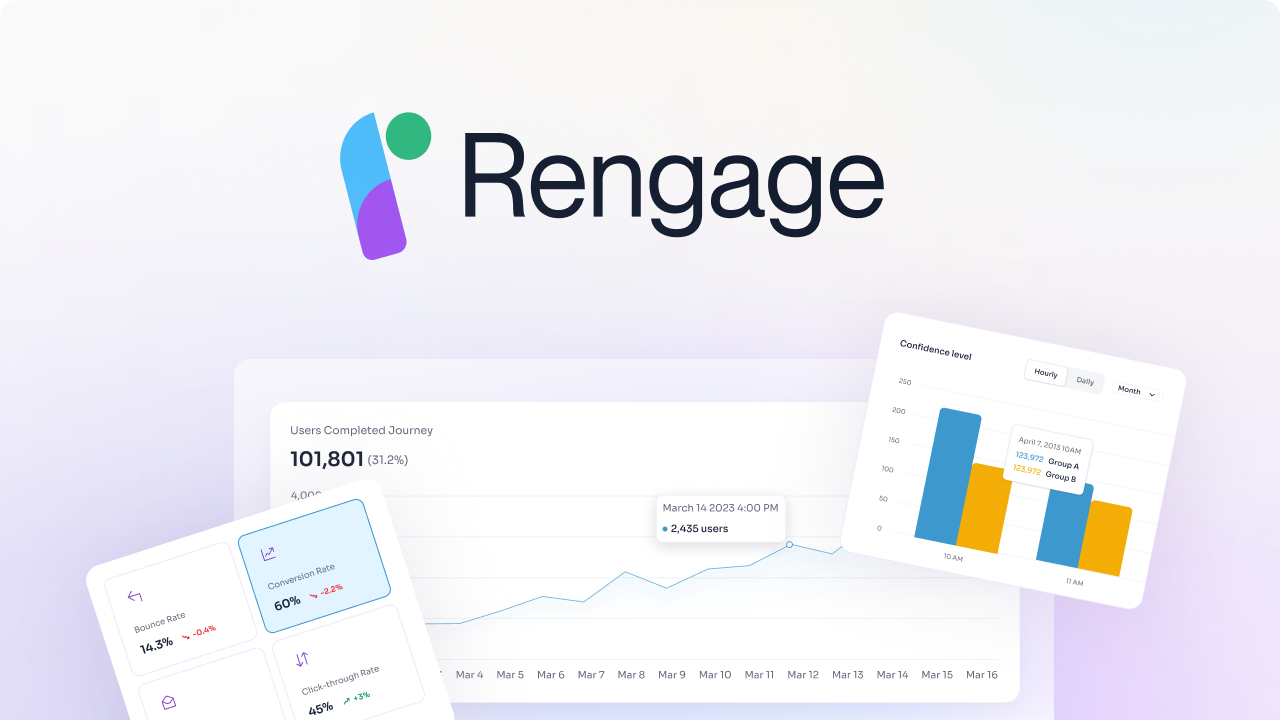Customer journey mapping tools are an essential component of effective customer lifecycle management. Understanding the needs, preferences, and behavior of your customers is crucial for business success. Customer journey mapping tools offer insights into the customer's experience, helping you create a more personalized and efficient customer journey. From streamlining the customer's buying process to improving the user experience, these tools are indispensable. Dive into this blog to learn more about customer journey mapping tools and how they can benefit your business.
What Is a Customer Journey Mapping Tool?

Customer journey mapping (CJM) is a visual representation of the entire customer journey your customers take when they engage with your brand or product. It helps you understand what customers are thinking and feeling at each stage of their journey. This contextual information helps you identify areas of improvement and seize new opportunities with your audience.
Explaining How Customer Journey Mapping Tools Enhance the Process
Understanding customer behavior is key. This means putting yourself in your customer's shoes and understanding their needs and wants. This is where customer journey mapping tools come in. They allow businesses to visualize touchpoints, understand customer behavior patterns, and identify areas for improvement.
Visualizing Touchpoints
The right CJM tool lets you visualize customer touchpoints. This means seeing all the different ways your customers interact with your brand. Every time a customer interacts with your brand, whether on social media, your website, or in-store, it is a touchpoint.
Understanding Customer Behavior
The right CJM tool lets you learn from your customers and understand their behavior. You can learn about their needs, wants, and what the motivations are behind their actions. This data is essential for driving positive changes in the customer journey.
Identifying Areas for Improvement
The right CJM tools help identify areas for improvement in the customer journey. By analyzing your data and looking for patterns, you can improve the customer experience. This means creating a more meaningful experience for customers.
Core Functions of Customer Journey Mapping Tools
A great CJM tool allows you to understand what is happening across your customer touchpoints. It helps you identify patterns and trends, and it gives you the insights you need to make data-driven decisions. When considering a CJM tool, look for a tool that visualizes your customer journey data in an intuitive and compelling way.
The 2 Types of Customer Journey Mapping Tools

1. Journey Map Visualization and Design Software
Journey map visualization and design software is the first category of tools used in customer journey mapping. These tools are designed for creating dynamic visualizations of a customer’s journey at various touchpoints across multiple channels.
They offer customer journey mapping templates tailored to a company’s objectives and allow for collaboration across teams, departments, and stakeholders to keep maps updated. This type of software focuses on the creation and design of customer journey maps.
2. Customer Journey Analytics Software
On the other hand, customer journey analytics software is focused on capturing, storing, and organizing customer behavior data along a product journey. In essence, this category is referred to as customer journey analytics software. These platforms concentrate more on the data that could inform a customer journey map rather than the actual creation of the map itself.
Maximizing Lead and Customer Engagement with Advanced Tracking and Optimization
While these software platforms also offer a map, journey, or user flow feature, their main emphasis is on monitoring, tracking, and analyzing lead or customer behavior across diverse channels. Besides, they automate the testing and optimization of customer-facing messaging and campaigns and integrate seamlessly with marketing, sales, or e-commerce solutions.
"Journey maps are living documents! Don't set goals around being ‘done.’ It's more important to work towards being accurate and that may take multiple sessions and sources of input that will change over time." ~Danielle Beecham, Lead UX Researcher at Viz.ai
Enriching Customer Journeys with Rengage to Drive Loyalty and Growth
We provide a comprehensive solution for managing and enhancing customer journeys, delivering insights and measurable outcomes with no code. We accelerate your customer journey from onboarding, activation to conversion and churn. Enabling customers to unlock revenue from their existing user.
With Rengage, you can get insights into your segments, run campaigns with an intuitive journey manager, and get insights to measure how your journeys impact users conversion through our Journey Moments and Journey Builder features.
- Journey Moments: insights into your micro-segments
- Journey Builder: intuitive multi-channel marketing automation
- Insights prediction and attribution
Book a free demo to learn about how you can transform customer interactions into personalized experiences that drive loyalty and growth.
Related Reading
10 Benefits of Using a Customer Journey Mapping Tool

1. Walk in your customers’ shoes
Customer journey mapping tools allow businesses to collect real-world insights on how customers interact with their brand, enabling them to empathize with the customer experience. This helps challenge assumptions and prioritize website and product improvements based on customer struggles, frustrations, and drop-off points.
By building a culture of customer-centricity, stakeholders view the brand from both the customer perspective and the business perspective. This tool helps observe sales experiences from the customer's point of view, offering opportunities to understand customer decision-making and preferences better.
2. Identify Unmet User Needs
Understanding customer needs across different interactions helps identify gaps in the customer journey, allowing businesses to offer additional touchpoints or improve existing ones. Mapping customer navigation through websites or apps helps pinpoint blockers and areas where customers struggle to engage or complete actions.
This increased awareness of customer needs allows for the minimization of frustrations by providing the right information and features at specific stages for a better user experience. For instance, offering explanatory videos or pop-up tooltips during onboarding touchpoints can improve customer understanding of a product or service.
3. Understand Complex Journeys Across Several Customer Touchpoints
Mapping tools visualize complex, non-linear customer journeys across multiple touchpoints, considering that customers interact with brands through various channels. This visualization helps businesses understand what customers are thinking, feeling, and doing at each stage, which informs the delivery of the right information at the right time, place, and channel.
With different customer segments preferring various platforms and content types, such as Gen Zers who prefer social media and video content, businesses can tailor their customer experience accordingly.
4. Visualize Emotions, Not Just Actions
Customer journeys are often emotional, and mapping tools help visualize customer emotions, which can be challenging to quantify. Understanding what customers are thinking, feeling, and doing helps businesses meet deeper customer needs and build trust with customers by showing that they understand their concerns. This understanding guides businesses in designing products and services that resonate with customers emotionally.
5. Create Personalized Experiences
Mapping tools allow businesses to dig deeper into user intent and interactions, creating personalized experiences across all touchpoints. By segmenting customer groups and tailoring experiences to each segment, businesses can enhance customer satisfaction and loyalty. For example, personalized landing pages, social media ads, support channels, and onboarding processes can improve the overall customer experience.
6. Align Cross-Functional Stakeholders
Customer journey mapping tools facilitate collaboration among various teams, including UX, marketing, product, sales, customer service, and shipping teams. By bringing different perspectives together, businesses can solve customer journey issues faster, leading to faster improvements for users. This alignment reduces politics and guesswork around customer preferences, clarifies areas of ownership and accountability, and creates a coherent customer interaction strategy.
7. Improve ROI and Cost-Effectiveness
Customer journey mapping tools offer opportunities to improve onboarding and feature adoption, which can increase customer satisfaction, loyalty, and product advocacy. By creating satisfied customers, businesses enhance ROI and reduce customer acquisition costs, ultimately boosting profitability.
8. Get a Competitive Edge
Mapping tools help businesses identify ways to improve the customer experience, differentiate their product from competitors, and identify new value propositions. By staying relevant, adapting to customer needs, and gaining insights into 'halo' customers and early adopters, businesses can gain a competitive edge in their market.
9. Improve Marketing and Product-Led Growth
Businesses can leverage journey mapping to understand customer behavior from the initial search phase to the final purchase, enabling them to create targeted content that converts visitors into paying customers. This process is particularly valuable for businesses with complex buyer journeys and high-value products, such as SaaS or B2B companies.
10. Minimize Future Roadblocks
While customer journey mapping tools require time and effort upfront, they can help businesses anticipate future challenges, minimize roadblocks, and reduce assumptions across teams. By conducting customer interviews and collecting qualitative and quantitative data, businesses can prevent issues down the line, saving resources and improving efficiency.
42 Must-know Customer Journey Mapping Tools
1. Rengage

We provide a comprehensive solution for managing and enhancing customer journeys, delivering insights and measurable outcomes with no code. We accelerate your customer journey from onboarding, activation to conversion and churn. Enabling customers to unlock revenue from their existing user.
With Rengage, you can get insights into your segments, run campaigns with an intuitive journey manager, and get insights to measure how your journeys impact users conversion through our Journey Moments and Journey Builder features.
- Journey Moments: insights into your micro-segments
- Journey Builder: intuitive multi-channel marketing automation
- Insights prediction and attribution
Book a free demo to learn about how you can transform customer interactions into personalized experiences that drive loyalty and growth.
2. Aiava
A modeling tool for customer journeys that uses storytelling as a framework. Features include text-to-visual design, rich media content attachments, multiple map views, and scenario walking. Collaboration features include comments, suggestions, and pain-point marking
3. Custellence
For customer experience (CX) teams interested in service blueprints and journey maps. Uses a “lane-based interface” with a drag-and-drop cards structure for more customization. Includes templates for a range of processes and journeys. Presentation settings offer view control.
4. Flowmapp
A visual platform for planning, designing, and mapping sitemaps, user flows, content hierarchies, information architecture, and project wireframes. Includes templates, workspace organization, import/export formats, real-time commenting for collaboration, and project-specific statuses
5. JourneyTrack
A customer journey management platform that includes persona and workshop support. Features include an atlas to weave journeys through other processes (such as funnels), metrics and data visualization, opportunity scoring (via a jobs-to-be-done framework), and integration with prototyping, database, and repository tools.
6. ShiftX
Offers business process mapping (BPM), including customer or user journeys. Features include a robust onboard keyboard shortcut system, an automatic map flow layout designer, customizable persona creation, real-time visual collaboration, and issue categorization to identify ongoing pain points
7. Smaply
Has two version:
- Classic (currently live)
- Forthcoming “3.0” version (access granted in batches)
The classic version offers design and management of journeys, personas, and stakeholder maps. Journey mapping features include a repository, hierarchy assignments, integrations with project management software, and customizable exports.
8. Theydo
Focuses on journey management: mapping, structuring in a framework, and uncovering opportunities across them. Includes a template library for blueprints, funnels, lifecycles, and even roadmaps. Offers integrations with different tools categories, including analytics, design/prototyping, product and project management, and impact tracking
9. UXPressia
Create customer journey maps, user personas, and map the impact of your product. Offers a repository for the assets needed to create and manage maps, such as statuses and tags. Additional features include:
- Journey-specific taxonomies
- Cross-team collaboration
- Standardization for new maps
- Templates for a variety of journey types
10. CleverTap
For creating personalized product experiences, in-app experiments, optimizations, and broader campaign creation (including journeys). Offers multiple customer data collection streams and analysis approaches, including some leveraging artificial intelligence. Offers industry-specific features for SaaS and gaming companies.
11. Contentsquare
A digital experience platform (DXP) focused on capturing and centralizing customer analytics data for use in creating journeys, user segments, heatmaps, and sessions. Has three core feature areas:
- Analytics (heat maps and journeys)
- Monitoring (error and speed analyses)
- Product analytics (retention reporting and segmentation)
Pricing is not publicly available from their marketing site.
12. Churnzero
Customer success software focused on customer engagement and retention. Offers features around customer data (profiles and segmentation), analysis (health scores and renewal forecasting), collaboration (journeys and in-app messaging), revenue forecasting (advanced reporting and in-app surveys) and robust workflow creation and automation. Pricing is not publicly available from their marketing site.
13. Glassbox
Focused on creating a complete profile of customer engagement and retention across any digital property. Their tool suite includes:
- Mobile app analytics
- Journey analysis
- Session capture and replay
- Interaction maps
- Funnel creation
- Performance metrics
- Voice-of-customer engagements
- Artificial intelligence for real-time support and guidance
14. Milkymap
A CX platform focused specifically on journey map creation, development, and management. They offer a framework for structuring customer experience metrics and bring them into journey mapping design. Offers APIs to connect other data streams, a variety of visualization styles, and KPI integration for team-wide alignment and collaboration
15. MoEngage
An insights-focused experience management and engagement platform. Features enable:
- The collection of customer data
- Journey orchestration and mapping
- Website personalization
- Omnichannel communication
- Artificial intelligence campaign optimization
- Real-time purchase transaction alerts via an API
16. Planhat
A “horizontal” customer platform for post-sales engagement and management. The tool is organized around four actions:
- Centralizing customer data for a 360 view
- A no-code way to create automations, triggers, and alerts via bots and integrations
- Building journeys that combine tasks with conditional sequencing
- A presentation suite to share findings and stories
17. WebEngage
A “retention operating system” for unifying customer data to personalization and automate campaigns. Offers tools: to create customer profiles via data integrations; design paths, funnels, or cohorts; orchestrate user journeys; surface notifications based on segmentation; and communicate via app, web, email or various ads platforms.
18. Hotjar
Hotjar Funnels shows you the path of the journey, while Heatmaps and Recordings show you how users behave along the way—where they click and scroll, where they get stuck, and the actions they take as they navigate from page to page. Hotjar’s tools also offer built-in automations—like AI for Surveys—and team collaboration features, including Highlights, which makes insight sharing quick and painless.
19. Google Analytics 4
Google Analytics 4 is a web analytics tool that tracks and measures website traffic metrics, like bounce and exit rates, goal conversions, sources of traffic, and user demographics. GA tells you how much traffic your website gets, where it comes from, and which channels convert best. You can also see what your most popular landing pages are and where people are exiting from your website.
20. Heap
Heap is a no-code product analytics tool that gives you customer data on how people use your product, tracking every stage of the customer journey. This tool comes in handy when you’re looking for customer pain points with your product and you need data to help you make decisions aimed at increasing customer retention and reducing churn. Heap helps you understand which customer segments your users come from, giving you more granular insight into the customer journey.
21. Clarabridge
Clarabridge is an AI-powered feedback text analytics tool that collects what people say about your brand or business from every possible source and analyzes how they feel about you. This tool is the way to go if you want to know how people really feel about your brand and business, and what the general user sentiment is. Use Clarabridge when people are already talking about your company: either on your website (through chats and surveys) or off your site (like on social media platforms).
22. InMoment
InMoment is an experience-intelligence (IX), AI-powered feedback tool that helps you get more detailed feedback from users. For example, if you ask your users about their experience and they say ‘Good’, InMoment prompts them further: ‘What was good?’ It also offers social monitoring that gathers meaningful feedback on what your customers are saying about you online.
23. Miro
Miro is an online whiteboard workspace that’s great for remote teams who want to brainstorm and put their thoughts onto a shared digital whiteboard. The software lets you create a board from scratch—so you can still use your sticky note strategy, just digitally—or use one of their pre-made templates.
24. Lucidchart
Lucidchart is a visual tool, capturing the customer experience. With customizable templates and formatting options, this customer journey mapping software lets you easily visualize and share your findings, helping you target specific personas, increase customer engagement, and ultimately increase your organization’s revenue.
25. Microsoft Visio
Microsoft Visio is software used for creating a variety of diagrams and flowcharts. With this visualisation tool, users can create simple or more complex customer data diagrams. It also offers a wide variety of built-in shapes, objects, and stencils to work with. The main idea behind Visio is to make diagramming as easy as possible for the user and therefore simplifying the process of customer journey mapping. Note: this is a Microsoft product, sold as an addition to MS Office.
26. Gliffy
Gliffy is a web-based editor and visualization tool used to create and edit diagrams. Though Gliffy is a bit too lightweight for highly technical diagrams, especially those that require collaboration to draft, it offers plenty of simple features such as Venn diagrams and organisational charts.
27. OminGraffle
OmniGraffle (created by OmniGroup) is a diagramming and customer journey mapping tool that can be used for everything from wireframe design to interior design. With this tool, users can create precise and neat customer journey maps that can then be shared with colleagues.
Everyone from professional artists and designers to casual data mappers and beginning diagrammers can make use of OmniGraffle. What makes OmniGraffle exceptional is how easy it is to get started. They also offer a free trial to test out the tool first.
28. IBM Journey Designer
IBM Journey Designer allows users to produce customer journey maps in minutes. Marketing, sales and customer service can collaboratively visualise cross-channel journeys, set common marketing goals and design tailored customer experiences for various priority segments in a user-friendly, drag-and-drop interface. Users can also engage in conversations, send files and notify team members of any activities while building customer journeys.
29. Visual Paradigm
Visual Paradigm’s online Customer Journey Mapping and development tool suite helps you streamline the UX initiatives and automate the entire information acquisition process. You can zoom-in on a single customer journey in a specific channel. By understanding the customer journey you can improve customer retention and increase the conversion rates. It also includes various agile project tools such as the PM Process Tool, Agile Process Tool, Scaled Scrum Process and more.
30. SuiteCX
SuiteCX is an easy-to-update tool with an intuitive interface that combines diagnostics, storytelling, prioritisation and planning into a powerful and comprehensive customer experience management platform. This customer journey mapping tool provides several Customer Journey Mapping (CMJ) visualisation templates and tools with all interaction and segment information kept in a centralised database.
31. cx/omni CEM Cloud Customer Journey Mapping Software
cx/omni CEM cloud is a customer experience management platform for internal communication of all CX/UX insights which includes a customer journey mapping tool. This CEM helps you monitor customer sentiment, various pain points, emotional journeys, and even performance gaps. Users can also access real-time feedback data.
32. Qualtrics
Qualtrics is an Experience Management software with solutions available for customer experience and employee experience as well as experience and research. They recently strengthened their Voice of the customer feedback tool by acquiring the popular software Clarabridge. This AI-powered solution offers a lot of listening insights and is able to detect both emotion and intent.
33. Trello
Trello is a visual collaboration tool for planning tasks and projects. While commonly used by agile software development teams, the solution is also used in other departments such as marketing, sales, support and HR. It works great for customer journey mapping too.
Trello makes it much easier for teams to work together organizing, prioritizing and creating detailed maps. Users can add comments or attachments to ‘cards’ (which represent tasks). Trello integrates with a number of online applications including JIRA Cloud, Bitbucket Cloud, Google Drive, GitHub and Slack.
34. Asana
Asana is a project and task management app that facilitates team communication and collaboration. Users can also use this tool to create customer journey maps and enable teams to track them collaboratively from beginning to end. It is possible to add team members to projects and tasks, share files and communicate with them.
As soon as a change is made or a task is assigned, users will receive notifications in their inbox which invite them check, follow, like, or comment the update. Users can also be mentioned in task comments to keep them in the loop with new updates.
35: UpWave
UpWave is an advanced task manager for small and medium business that offers lots of unique features. This tool has a very modern interface with lots of detailed tutorials making it easy-to-use. UpWave gives digital teams the opportunity to plan and share tasks and ideas by way of visual boards.
These boards help them to track workflows and streamline productivity. All information is stored in a cloud so that each team member can access it regardless of the device he/she is using.
36. Mural
Mural is a great collaboration tool in which users can create and share items to keep stakeholders informed. With built-in templates and frameworks, users are able to gain insights much more quickly. Communicate visually using sticky notes, flowcharts and mapping, drawings, and so much more. This tool can be accessed from any device using your web browser or native apps for Windows 10 and iOS.
37. Mapovate
Mapovate is a unique customer journey mapping solution, thanks to its dynamic real-time voice of customer analytics. Mapovate is easy to use and designed to support users in drawing and visualising customer journeys. You can create personas and define journeys of different customer profiles, get email alerts and notifications to create follow-up actions and collaborate with team members to improve experiences.
38. Workzone
Workzone is an easy-to-use, cloud-hosted project management and document collaboration app that is great for customer journey mapping. Around since 2000, this tool is rated among the most mature online project management software in the market. You can use Workzone to organise projects with tasks and subtasks, assign responsibilities, and be notified when a task is due. You can also connect tasks together to see how a change in a single area impacts the rest of the project.
39. FigJam by Figma
FigJam is a whiteboard tool developed by Figma. It's designed to make brainstorming, ideation, and mapping out customer journeys a whole lot easier.
40. InDesign CC
InDesign is a page layout design software from Adobe, which means for a bit of a steep learning curve, you can unlock unlimited flexibility. You can build, convert, edit, and collaborate on complex visual design projects. This robust tool has everything you need to build customer journey maps and much more, such as logo design, social media graphics, and media kits.
41. Totango
Totango is a customer success platform that can help you manage your customer experience and map your customer journey for digital products. You can use it to track product usage and adoption and measure the success of your customer success initiatives.
42. Reveall
Reveall is a product discovery platform that allows you to map customer journeys to know how your client experiences different aspects of your product.
Related Reading
- Digital Customer Journey Mapping
- Customer Journey Analysis
- Ecommerce Customer Journey
- B2B Customer Journey
- Customer Journey Orchestration
- Omnichannel Customer Journey
- Saas Customer Journey
- Marketing Automation Customer Journey
- Customer Journey Optimization
- Micro Moments Customer Journey
- Customer Journey Research
- Customer Journey Automation
- Customer Journey Insights
- Customer Journey Dashboard
- Customer Journey Personalization
- Customer Journey Metrics
- Customer Journey Best Practices
9 Key Features to Consider When Choosing a Customer Journey Mapping Tool

1. Intuitiveness and functionality
When selecting a customer journey mapping tool, consider the intuitiveness and functionality of the software. An easy-to-use tool with a shallow learning curve will help you get started immediately. Features like drag-and-drop functionalities, touchpoint mapping, and persona creation can streamline your workflows and make creating journey maps a breeze.
2. Multichannel journey mapping
Multichannel journey mapping allows you to capture data and analyze customer touchpoints from various channels like your website, mobile app, social media, physical store, and customer service database. This comprehensive approach helps you identify key touchpoints and friction points in the customer journey, enabling you to make informed decisions to enhance customer satisfaction.
3. Analytics
Customer journey mapping tools with built-in analytics features let you analyze customer touchpoints, behavior, and personas. These insights help you identify pain points in the customer journey and develop strategies to improve the overall customer experience.
4. Built-in templates, resources, and support
Look for tools that offer built-in templates to help you get started with creating your customer journey map. Customizable templates allow you to tailor them to your specific needs, while resources like documentation, training, and onboarding sessions facilitate the learning process. Having access to troubleshooting manuals and helpdesks can also be crucial in case you encounter any issues.
5. Linking
Consider whether you’ll need to create multiple customer journey maps for related projects or to illustrate hierarchies. Look for tools that allow you to link different maps to reuse findings and gain a comprehensive understanding of multiple customer journeys.
6. Flexibility
The best customer journey mapping tools support an iterative process, enabling you to refine and enhance your journey maps over time. These tools should allow you to add steps to a journey and make real-time changes to optimize the customer experience.
7. Different views
Tools that offer various perspectives to analyze customer journeys, such as heatmaps, storyboards, and emotional journey mapping, provide a holistic understanding of the customer journey. The ability to view journeys from different angles can offer valuable insights into customer behavior and preferences.
8. Integration
Integration capabilities are crucial for customer journey mapping tools to work seamlessly with other platforms in your marketing technology stack, such as marketing automation tools, CRM software, and CDPs. This integration allows you to consolidate data from multiple sources and incorporate customer journey insights into your existing processes.
9. Collaboration tools
Customer journey mapping tools that support collaboration enable team members to work together on journey maps in real time. Features like change tracking and commenting help streamline internal processes and foster better teamwork and communication.
Create Personalized Experiences That Drive Loyalty and Growth with Rengage — Book A Free Demo Today
Rengage provides a comprehensive solution for managing and enhancing customer journeys, delivering insights and measurable outcomes with no code. We accelerate your customer journey from onboarding, activation to conversion and churn, allowing you to unlock revenue from your existing user base.
With Rengage, you gain insights into your segments, enabling you to run campaigns with an intuitive journey manager to impact users' conversion. Our Journey Moments feature provides insights into your micro-segments, while the Journey Builder offers intuitive multi-channel marketing automation. Our platform provides insights, predictions, and attribution modeling to measure the impact of your customer journeys on user conversion.
Book a free demo with Rengage to learn how you can transform customer interactions into personalized experiences that drive loyalty and growth.
Related Reading
- Customer Lifecycle Management Software
- Customer Journey Management
- Braze Alternative
- Fullstory Alternatives
- Adobe Analytics Alternatives
- Customer Journey Analytics Tools
- Iterable Competitors
- Marketo Alternatives
- Onesignal Alternatives
- Clevertap Alternatives
- Bloomreach Alternatives
- Customer.io Alternatives
